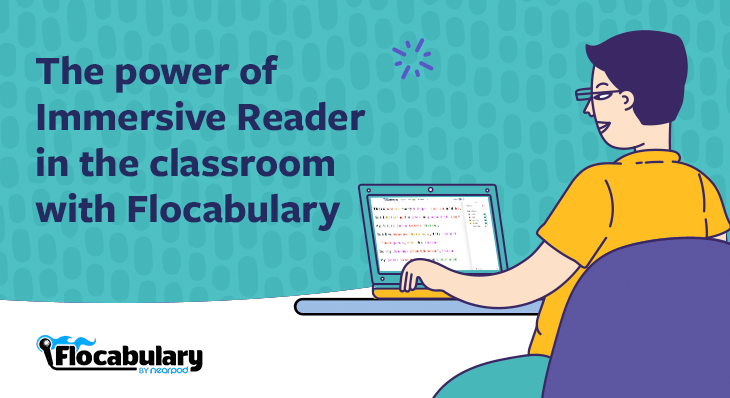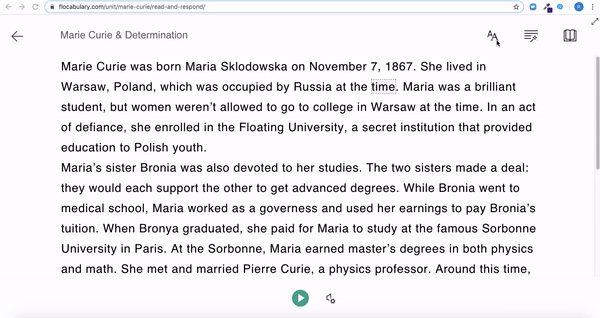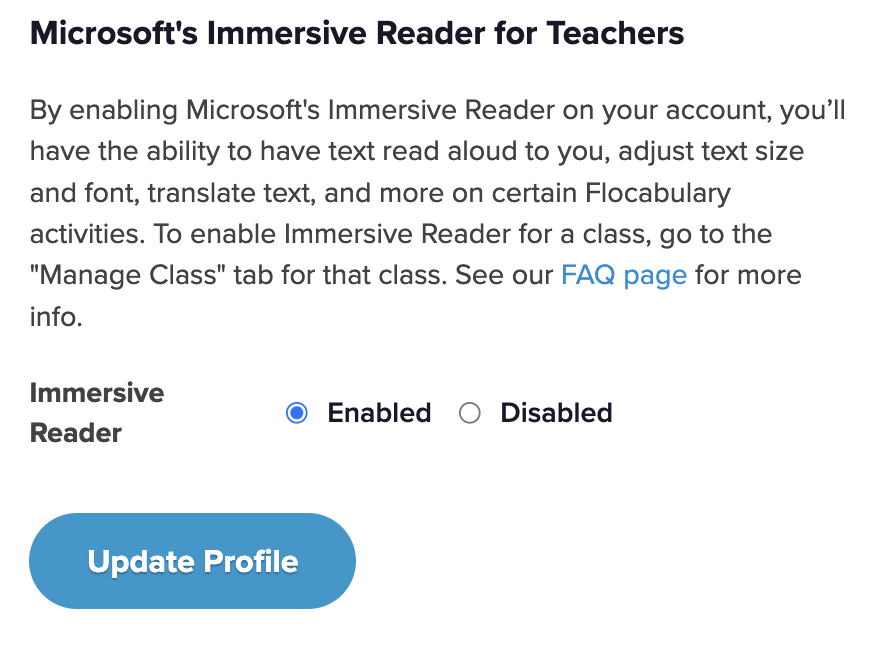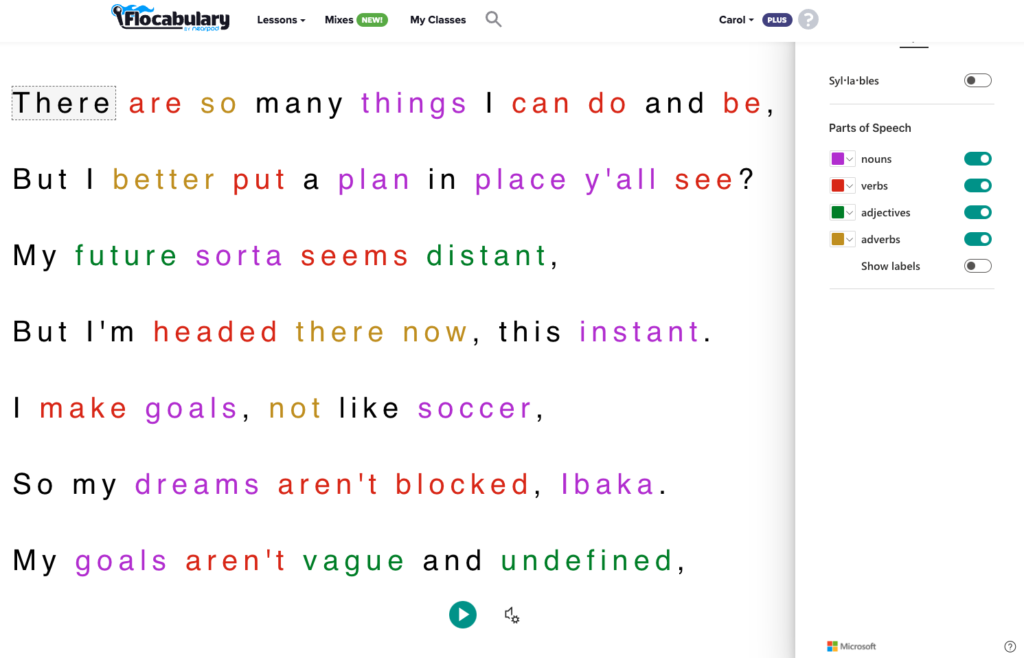
The power of Immersive Reader in the classroom with Flocabulary
When it comes to edtech adoption, one of the top criteria should be to evaluate resources with accessibility in mind. Beginning with the Rehabilitation Act of 1973 and IDEA (the Education of Handicapped Children Act) in 1975, public education began to pay closer attention to supporting those with physical and cognitive disabilities. In recent times, advocates and legislators have shone a spotlight on accessibility inequities when it comes to digital resources, from hardware to software to online programs and sites. Districts have far-reaching policies and guidelines in place around edtech adoption due to these seminal laws (read more about Web Content Accessibility Guidelines (WCAG 2.2) and Sections 504 and 508). Because of this, more and more sophisticated tools have become available to address students’ special needs, but these advancements, in turn, support all learners’ needs.
What is Immersive Reader?
In 2016, Microsoft released Immersive Reader, which it describes as “a free tool that uses proven techniques to improve reading for people regardless of their age or ability.” Designed for inclusivity, Microsoft’s Immersive Reader can benefit those with learning differences like dyslexia, as well as engage emergent readers looking for a bit of a confidence boost. Not only does it offer text decoding solutions with features like dictation, syllabification, and parts of speech, it can also improve fluency and confidence for all readers, including English Language Learners (ELLs).
Learners can have Immersive Reader read aloud with the aptly named Read Aloud feature, which changes text to speech. Learners can also change the sound, speed, and language of the voice. Other features like Text Spacing or Column Width adjust the formatting of text to support those with visual impairments or emergent readers in general. The comprehension mode even improves comprehension by 10%. Immersive Reader even supports math skill building for those with dyscalculia by reading math problems out loud. Immersive Reader also offers a picture dictionary alongside language translation. Now, anyone can turn on Immersive Reader within Flocabulary, ensuring that Flocabulary’s benefits are inclusive of all learners.

New to Flocabulary? Teachers can sign up for a trial to access our lesson videos and assessment activities. Administrators can get in touch with us to learn more about unlocking the full power of Flocabulary through Flocabulary Plus.
What are the benefits of Immersive Reader in the classroom?
Immersive Reader is yet another tool that teachers can use to build a positive classroom culture that is safe and supportive by being inclusive to all. In doing so, Flocabulary with Immersive Reader can better develop reading skills, spanning learning objectives from decoding skills to language comprehension as part of any Science of Reading (SOR) approach. From vocabulary acquisition to reading comprehension, students can choose from a wide range of Flocabulary videos that engage them in literacy-based skills. Teachers will have an ally to help them personalize and target instruction to each and every student so that they can learn at their own pace and in their own style.
Each student will have the option to employ Immersive Reader on their own, thereby empowering them to lean on learning aids as needed. They won’t have to call attention to themselves in asking for differentiation. Instead, they can find support just in time, whether learning in the classroom or at home. Students can begin to grow their confidence as readers and as learners overall, bolstered by seeing progress from activity to activity.
A guide to using Immersive Reader with Flocabulary
1. How to turn on Immersive Reader in Flocabulary

Immersive Reader is available for free within all Flocabulary subscriptions and can be activated on the digital version of lessons’ lyrics, as well as in the Vocab Card, Read & Respond, Vocab Game, Quiz, Lyric Lab, and Break It Down activities. Turning on Immersive Reader is quite easy:
- Go to My Profile.
- Scroll down to the bottom, and select “Enabled” for Microsoft’s Immersive Reader.
- Click “Update Profile.”
You can enable Microsoft’s Immersive Reader for students in two ways:
- When first creating a class on Flocabulary, click “Select students” under Immersive Reader and then “All Students” to default to ON for all students when they join the class.
- If a class already has students, go to My Classes, click on the class, and click the Manage Class tab. Click “Edit” under Class Settings, and click “Select Students” under Immersive Reader. Select “All Students” (or select specific names) and save your selection.
You’ll be able to see whether Immersive Reader is on or off for students in the Students tab within a class.
2. Where can Immersive Reader be used on Flocabulary?
| Where to find Immersive Reader on Flocabulary | What can Immersive Reader do? |
| Lyrics Vocab Card Read & Respond Vocab Game Quiz Lyric Lab Break It Down | Have text read aloud to them and adjust the speed of the voice Adjust text size, font, and color Label the parts of speech Translate words in a text or an entire block of text View image references for words |
On the corresponding activities, students will see a book icon in the upper left-hand corner of the activity. They can click on the Immersive Reader icon—a book—to go into Immersive Reader mode. The play button activates the Read Aloud feature, and the voice settings button will modify the voice. At the top right of the screen are the text preference options, the grammar options (syllables!), and reading preferences for Focus Mode and translations.
3. Boost vocabulary acquisition
Did you know that academic vocabulary is a leading indicator of student comprehension? Students need as many as 17 exposures to a new work in a variety of contexts to move into their long-term memory (Marzano). Hip-hop has 2-3 times the number of words per song compared to other genres, making it the perfect format to teach academic vocabulary. Flocabulary’s video lessons are infused with hip-hop components. Teachers can leverage these videos for vocabulary acquisition by having students review the lyrics with Immersive Reader.
Additionally, these lessons provide students with visual and contextual clues to make meaning of new vocabulary, and they provide activities through Vocab Cards and Vocab Games. Immersive Reader can help decode words, provide translations, and adjust text formatting so that students have ample opportunity to develop new lexicons. With Lyric Lab, students can engage in wordplay to better understand the rules of English (one of the most complicated languages to master due to deviations in pronunciation, complex syntax rules, and a myriad of exceptions).

4. Improve student comprehension
Such vocabulary development leads to improving student comprehension. Flocabulary offers a Break It Down* activity for each video, which is a quick 3-question assessment of the skill taught. With a multiple-choice question, a video evidence question, and an open-ended question, this activity evaluates students’ comprehension in a variety of ways. And Immersive Reader can be employed to further aid students’ reading with text-to-speech and translation support. Immersive Reader can support Read and Respond activities by reinforcing both fiction and nonfiction texts that resemble high-stakes tests as necessary. Flocabulary’s engaging multimedia approach appeals to all learning styles, and Immersive Reader can be layered on Quizzes to ensure that students have the opportunity to “show what they know” without accessibility or reading challenges getting in the way.
*Break it Down is only available to users with a Flocabulary Plus subscription.
5. Keep students focused and interested
The name of the game in education is engagement: How can teachers keep kids intrinsically engaged and curious to learn? Flocabulary’s videos are memorable and appealing since they use visual art, storytelling, and hip-hop music to teach skills. This mix of poetry, humor, and drama quickly sparks joy and captivates viewers. Plus, the videos hold their attention, helping them to retain what they learned.
When it comes to the text, though, Immersive Reader is an additional learning aid that can keep students on task through Focus Mode. Focus Mode minimizes distractions. With reduced visual clutter, readers can experience enhanced concentration. Also, Immersive Reader allows for the font’s formatting to be modified, whether with the spacing and length of lines of text or the size and space of the font itself. Making the text more reader-friendly helps to make the content more digestible and easier to comprehend.
Start using Flocabulary with Immersive Reader
The winning instructional design of Flocabulary appeals to learners of all ages, abilities, and styles, and Microsoft’s Immersive Reader boosts its effectiveness by allowing learners to fully engage as they customize how they access the content. The cornucopia of features—from Read Aloud to Text Spacing—puts the onus of learning where it should belong: in the learner’s hands. Take a moment today to enable Immersive Reader within your Flocabulary subscription and default to having it on for all of your classes of students. These inclusive curricular tools make our classrooms more welcoming, more supportive, and more productive for all.
New to Flocabulary? Teachers can sign up for a trial to access our lesson videos and assessment activities. Administrators can get in touch with us to learn more about unlocking the full power of Flocabulary through Flocabulary Plus.
